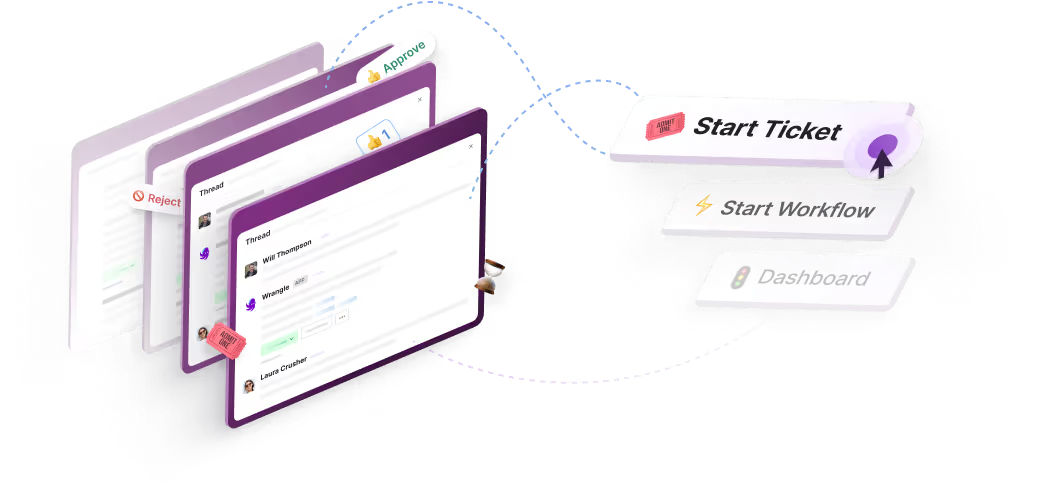How a Slack Ticketing System Can Save You Money
Wrangle is a Slack Ticketing System for the new way we work. Employees stay in Slack and don't switch context.

.png)
If an employee submits a request through a traditional ticketing system but no one at the help desk sees it, was the request ever sent?
We’ve all been there, and we’ve all wondered the same things. Did the ticket get to the other department? Has a supervisor assigned it yet? When does this department think they’ll be able to resolve this request? Those are the types of questions every employee asks when they've submitted a ticket for one of the following scenarios:
- Employees need help from IT in addressing a computer matter, resetting their password, or installing new software on their work devices.
- Human Resources gets a request for a particular type of training, approval for employee leave, or processing new medical or dental coverage.
- Facility equipment is malfunctioning, and the manager needs to report that to the relevant party to get fixed. This can include air conditioners, toilets that won’t stop running, and more.
On the other end of the ticketing system, the department must efficiently approve the task, assign it, and ensure their team is able to stay on top of it. They also need to measure how quickly they resolve requests from other departments so they can improve how they do business.
You can’t afford for your ticketing system to create headaches and delays in today’s dynamic economy. You need a solution allowing your team to easily communicate and access information in easily accessible formats.
Wrangle is a modern ticketing system delivering those results while functioning entirely in Slack.
Wrangle collects, organizes, and tracks every ticket submitted by employees and ensures the team responding to these requests has everything it needs to get the job done. In this article, we'll explain how Wrangle improves upon the traditional ticketing process so that your team can focus on satisfying your customers and earning new revenue.
What’s Wrong with Traditional Ticketing?
Traditional ticketing systems had their place when they were built, but unfortunately, they haven’t been able to adapt to the new way of working, where many people are remote. Here are some of the drawbacks you’ve probably encountered when working with a traditional system:
- Ticketing systems aren’t built to operate within Slack. Employees can’t keep track of their ticketed requests in the system they use the most.
- Ticketing systems aren’t always designed to interact with other programs. As a result, vital information remains in a silo.
- Employees must learn more than one system. Members of your team don’t use a ticketing system often—at least, we hope they don’t—so they might opt to just email someone directly instead of using a system with which they have less experience.
- Employees aren’t notified of the progress someone makes in resolving their request. Unless the employee personally reaches out to someone in the department they need, then they have no way of knowing who the ticket was assigned to, if the process has even been started, or an estimate for completion. That’s time and energy they’re not spending on their actual work.
- The team receiving the ticket has a harder time organizing its tasks. These teams use Slack like everyone else at their company, but they either can’t get the information automatically displayed there or they must search for bits and pieces of the information they need. That makes it more difficult for them to fulfill their co-workers' needs.
These types of issues may only be exacerbated by the growing trend of employees working from home. The Pew Research Center found more than half of surveyed adults would prefer to do their jobs from home, if allowed. Businesses are also considering whether a hybrid model—half the week in the office, the other half at home—would work better for its employees. As teams spread out, businesses must make it easier for their employees to submit and keep track of ticketed requests.
These might seem like minor inconveniences most companies have learned to live with, but businesses incur a financial cost when their employees can’t find information in general. According to the International Data Corporation, 61 percent of employees use at least four platforms while they’re at work, and they spend 36 percent of their day trying to find the information they need.
Here’s where this gets costly: companies pay $5,700 per employee annually because their employees can’t find the information they’re looking for.
Your employees already struggle to find information, and a traditional ticketing system often doesn’t help. What if you could reduce the annual cost to your company by making this aspect of life easier on your team?
Wrangle in a Nutshell
Recently highlighted as a Featured App in Slack's App Directory, Wrangle is a new approach to ticketing, built for chat-driven workplaces:
- Everything happens in Slack, so employees only need to use one system to submit tickets. No more context switching to other apps.
- Wrangle gives employees a menu of different types of tickets they can submit, with customizable forms to gather data on the request.
- Wrangle posts the ticket to a channel and will alert employees on the status of their request as the other department makes progress on it.
- Wrangle organizes the information the receiving team needs to assign the request and complete the job.
- Wrangle provides dashboards for the people on the receiving and requesting sides of the ticket, so they can track all their tickets in one place.
A Step-by-Step Guide to Modern Ticketing in Slack
How does Wrangle work? Let’s go through a step-by-step overview of what it’s like to use Wrangle to submit a common ticket request.
Submitting a Ticket
After you've installed Wrangle in your Slack workspace, you can start to build some of the intake forms employees will fill out that trigger a ticket for the department that handles that request. For the purposes of this section, let’s imagine one of those tickets is to ask the IT department to update software on your work computer.
The employee will fill out a form, designed in advance by the IT department to collect the information it knows it requires to complete this job. (Other departments, such as human resources and marketing, can design their own forms.) In this scenario, the employee would likely submit their name, model of their computer, the software that needs to be updated, and so on. The employee will then submit that form through Slack.
The IT department will receive that completed form as a message in a channel and make the decision to either approve or deny the request. If the department approves the request—let's assume in this example that they will—then Wrangle will automatically reply to the request withinSlack with an approval, assigned to members of the IT team. Those reviewers can sign off on the request before any IT employee spends time on it.
Tracking Your Request
Once the ticket has been approved, Wrangle responds with a customizable set of follow-up tasks, assigned to an IT specialist. Both the IT specialist and the employee who submitted the form will be able to see all the tasks associated with the request on Slack and the progress IT has made. Wrangle will include these tasks in a threaded conversation within Slack.
In addition to easily providing access to the status of the request, Wrangle eliminates the need for employees to directly email someone to figure out if their request has been handled. Wrangle will notify them when the IT department checks off a task in the workflow. That saves the employee time and helps the IT specialist to focus on completing the job instead of responding to a series of follow-up emails.
Wrangle also gives supervisors the ability to set deadlines for tasks in the workflow, ensuring the IT specialist will be able to stay on target to complete the software update and promising the employee that they won’t have to wait indefinitely for their request to be completed.
Completing Your Request
When the IT department has successfully updated the software, they’ll mark the task as complete in Wrangle. Wrangle will notify the employee who submitted the form that their software has been successfully updated. Thanks to this streamlined communication, everyone involved in the process will always know where this job stands and when it’s done.
After the task is finished, Wrangle will log the job into a database for supervisors, who can use a dashboard within the WrangleApp to monitor how quickly jobs are being completed. Those supervisors can use this information to assess employee performance and recommend improvements to the workflows moving forward.
Learn More
A modern ticketing system operating entirely within Slack, Wrangle can cut down on the inefficiency and miscommunication typically associated with its traditional counterparts. Add the Wrangle App to Slack today to make life easier on your team, remove costly silos, and expand your bottom line.
Wrangle can also be used for approval workflows as well.

- Try Wrangle free for 14 days
- Turn messages into trackable tickets
- Build a scalable help desk



Turn Slack into a productivity powerhouse with Wrangle
Create a scalable helpdesk in Slack. Automatically turn messages into trackable tickets and provide faster, more transparent service to your colleagues and customers with Wrangle — Try it free!






